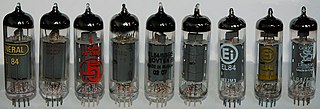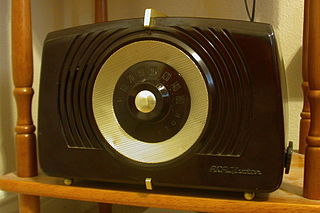
A diode is a two-terminal electronic component that conducts current primarily in one direction. It has low resistance in one direction and high resistance in the other.

A vacuum tube, electron tube, valve, or tube, is a device that controls electric current flow in a high vacuum between electrodes to which an electric potential difference has been applied.

The Selectron was an early form of digital computer memory developed by Jan A. Rajchman and his group at the Radio Corporation of America (RCA) under the direction of Vladimir K. Zworykin. It was a vacuum tube that stored digital data as electrostatic charges using technology similar to the Williams tube storage device. The team was never able to produce a commercially viable form of Selectron before magnetic-core memory became almost universal.

12AX7 is a miniature dual-triode 6AV6 vacuum tube with high voltage gain. Developed around 1946 by RCA engineers in Camden, New Jersey, under developmental number A-4522, it was released for public sale under the 12AX7 identifier on September 15, 1947.

6SN7 is a dual triode vacuum tube with an eight-pin octal base. It provides a medium gain. The 6SN7 is basically two 6J5 triodes in one envelope.

Tube sockets are electrical sockets into which vacuum tubes can be plugged, holding them in place and providing terminals, which can be soldered into the circuit, for each of the pins. Sockets are designed to allow tubes to be inserted in only one orientation. They were used in most tube electronic equipment to allow easy removal and replacement. When tube equipment was common, retailers such as drug stores had vacuum tube testers, and sold replacement tubes. Some Nixie tubes were also designed to use sockets.

The 6V6 is a beam-power tetrode vacuum tube. The first of this family of tubes to be introduced was the 6V6G by Ken-Rad Tube & Lamp Corporation in late 1936, with the availability by December of both Ken-Rad and Raytheon 6V6G tubes announced. It is still in use in audio applications, especially electric guitar amplifiers. Following the introduction in July 1936 of the 6L6, the potential of the scaled down version that became the 6V6 was soon realized. The lower-powered 6V6 was better suited for average home use, and became common in the audio output stages of "farmhouse" table-top radios, where power pentodes such as the 6F6 had previously been used. The 6V6 required less heater power and produced less distortion than the 6F6, while yielding higher output in both single-ended and push-pull configurations. Although the 6V6 was originally designed especially for use in automobile radios, the clip-in Loctal base 7C5, from early 1939, or the lower heater current 12V6GT, both with the identical characteristics to the 6V6, but with the smaller T-9 glass envelope, soon became the tubes of choice for many automotive radios manufacturers. Additionally, the 6V6 had applications in portable battery-operated radios.

In vacuum tubes and gas-filled tubes, a hot cathode or thermionic cathode is a cathode electrode which is heated to make it emit electrons due to thermionic emission. This is in contrast to a cold cathode, which does not have a heating element. The heating element is usually an electrical filament heated by a separate electric current passing through it. Hot cathodes typically achieve much higher power density than cold cathodes, emitting significantly more electrons from the same surface area. Cold cathodes rely on field electron emission or secondary electron emission from positive ion bombardment, and do not require heating. There are two types of hot cathode. In a directly heated cathode, the filament is the cathode and emits the electrons. In an indirectly heated cathode, the filament or heater heats a separate metal cathode electrode which emits the electrons.

The EL34 is a thermionic vacuum tube of the power pentode type. The EL34 was introduced in 1955 by Mullard, who were owned by Philips. The EL34 has an octal base and is found mainly in the final output stages of audio amplification circuits; it was also designed to be suitable as a series regulator by virtue of its high permissible voltage between heater and cathode and other parameters. The American RETMA tube designation number for this tube is 6CA7. The USSR analog was 6P27S.

The EL84 is a vacuum tube of the power pentode type. It is used in the power-output-stages of audio-amplifiers, most commonly now in guitar amplifiers, but originally in radios. The EL84 is smaller and more sensitive than the octal 6V6 that was widely used around the world until the 1960s. An interchangeable North American type is the 6BQ5.
In Europe, the principal method of numbering vacuum tubes was the nomenclature used by the Philips company and its subsidiaries Mullard in the UK, Valvo(de, it) in Germany, Radiotechnique (Miniwatt-Dario brand) in France, and Amperex in the United States, from 1934 on. Adhering manufacturers include AEG (de), CdL (1921, French Mazda brand), CIFTE (fr, Mazda-Belvu brand), EdiSwan (British Mazda brand), Lorenz (de), MBLE(fr, nl), RCA (us), RFT(de, sv) (de), Siemens (de), Telefunken (de), Tesla (cz), Toshiba (ja), Tungsram (hu), and Unitra. This system allocated meaningful codes to tubes based on their function and became the starting point for the Pro Electron naming scheme for active devices.

The 12AU7 and its variants are miniature nine-pin medium-gain dual triode vacuum tubes. It belongs to a large family of dual triode vacuum tubes which share the same pinout. 12AU7 is also known in Europe under its Mullard–Philips tube designation ECC82. There are many equivalent tubes with different names, some identical, some designed for ruggedness, long life, or other characteristics; examples are the US military 5814A and the European special-quality ECC82 and E182CC.

The 6N2P,, also sometimes spelled in English "6H2Pi", is a miniature 9-pin dual triode vacuum tube manufactured in USSR, Russia and China with characteristics similar to the 12AX7. The most significant difference between the two is that 6N2P has its two filament elements connected in parallel, unlike the series filament connection of the 12AX7, and it is thus only possible to operate it from a 6.3 volt, 340 mA filament supply

The 6N1P is a Russian-made miniature 9-pin medium gain double triode vacuum tube intended for use as a line audio amplifier and cathode driver.

An AC/DC receiver design is a style of power supply of vacuum tube radio or television receivers that eliminated the bulky and expensive mains transformer. A side-effect of the design was that the receiver could in principle operate from a DC supply as well as an AC supply. Consequently, they were known as "AC/DC receivers".

A tube tester is an electronic instrument designed to test certain characteristics of vacuum tubes. Tube testers evolved along with the vacuum tube to satisfy the demands of the time, and their evolution ended with the tube era. The first tube testers were simple units designed for specific tubes to be used in the battlefields of World War I by radio operators, so they could easily test the tubes of their communication equipment.

The type 955 triode "acorn tube" is a small triode thermionic valve designed primarily to operate at high frequency. Although data books specify an upper limit of 400–600 MHz, some circuits may obtain gain up to about 900 MHz. Interelectrode capacitances and Miller capacitances are minimized by the small dimensions of the device and the widely separated pins. The connecting pins are placed around the periphery of the bulb and project radially outward: this maintains short internal leads with low inductance, an important property allowing operation at high frequency. The pins fit a special socket fabricated as a ceramic ring in which the valve itself occupies the central space. The 955 was developed by RCA and was commercially available in 1935.

The 1N400x series is a family of popular one-ampere general-purpose silicon rectifier diodes commonly used in AC adapters for common household appliances. Its blocking voltage varies from 50 volts (1N4001) to 1000 volts (1N4007). This JEDEC device number series is available in the DO-41 axial package. Diodes with similar ratings are available in SMA and MELF surface mount packages.

















